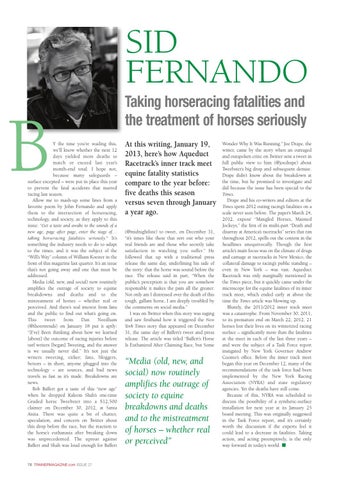FERNANDO NA ISSUE 27_Jerkins feature.qxd 01/02/2013 12:57 Page 1
SID FERNANDO
B
Y the time you’re reading this, we’ll know whether the next 12 days yielded more deaths to match or exceed last year’s month-end total. I hope not, because many safeguards – surface excepted – were put in place this year to prevent the fatal accidents that marred racing last season. Allow me to mash-up some lines from a favorite poem by John Fernando and apply them to the intersection of horseracing, technology, and society, as they apply to this issue: “Get a taste and awake to the sounds of a new age, page after page, enter the stage of… taking horseracing fatalities seriously.” It’s something the industry needs to do to adapt to the times, and it was the subject of the “Will’s Way” column of William Koester in the front of this magazine last quarter. It’s an issue that’s not going away and one that must be addressed. Media (old, new, and social) now routinely amplifies the outrage of society to equine breakdowns and deaths and to the mistreatment of horses – whether real or perceived. And there’s real interest from fans and the public to find out what’s going on. This tweet from Dan Needham (@thorotrends) on January 18 put it aptly: “[I’ve] Been thinking about how we learned [about] the outcome of racing injuries before turf writers [began] Tweeting, and the answer is we usually never did.” It’s not just the writers tweeting, either; fans, bloggers, bettors – in short, anyone plugged into the technology – are sources, and bad news travels as fast as it’s made. Breakdowns are news. Bob Baffert got a taste of this “new age” when he dropped Kaleem Shah’s one-time Graded horse Tweebster into a $12,500 claimer on December 30, 2012, at Santa Anita. There was quite a bit of chatter, speculation, and concern on Twitter about this drop before the race, but the reaction to the horse’s euthanasia after breaking down was unprecedented. The uproar against Baffert and Shah was loud enough for Baffert
76 TRAINERMAGAZINE.com ISSUE 27
Taking horseracing fatalities and the treatment of horses seriously At this writing, January 19, 2013, here’s how Aqueduct Racetrack’s inner track meet equine fatality statistics compare to the year before: five deaths this season versus seven through January a year ago. (@midnightlute) to tweet, on December 31, “it’s times like these that sort out who your real friends are and those who secretly take satisfaction in watching you suffer.” He followed that up with a traditional press release the same day, underlining his side of the story: that the horse was sound before the race. The release said in part, “When the public’s perception is that you are somehow responsible it makes the pain all the greater. Not only am I distressed over the death of this tough, gallant horse, I am deeply troubled by the comments on social media.” I was on Twitter when this story was raging and saw firsthand how it triggered the New York Times story that appeared on December 31, the same day of Baffert’s tweet and press release. The article was titled “Baffert’s Horse Is Euthanized After Claiming Race, but Some
“Media (old, new, and social) now routinely amplifies the outrage of society to equine breakdowns and deaths and to the mistreatment of horses – whether real or perceived”
Wonder Why It Was Running.” Joe Drape, the writer, came by the story when an outraged and outspoken critic on Twitter sent a tweet in full public view to him (@joedrape) about Tweebster’s big drop and subsequent demise. Drape didn’t know about the breakdown at the time, but he promised to investigate and did because the issue has been special to the Times. Drape and his co-writers and editors at the Times spent 2012 outing racing’s fatalities on a scale never seen before. The paper’s March 24, 2012, exposé “Mangled Horses, Maimed Jockeys,” the first of its multi-part “Death and disarray at America’s racetracks” series that ran throughout 2012, spells out the content in the headlines unequivocally. Though the first article’s main focus was on the climate of drugs and carnage at racetracks in New Mexico, the collateral damage to racing’s public standing – even in New York – was vast. Aqueduct Racetrack was only marginally mentioned in the Times piece, but it quickly came under the microscope for the equine fatalities of its inner track meet, which ended early at about the time the Times article was blowing up. Bluntly, the 2011/2012 inner track meet was a catastrophe. From November 30, 2011, to its premature end on March 22, 2012, 21 horses lost their lives on its winterized racing surface – significantly more than the fatalities at the meet in each of the last three years – and were the subject of a Task Force report instigated by New York Governor Andrew Cuomo’s office. Before the inner track meet began this year on December 12, many of the recommendations of the task force had been implemented by the New York Racing Association (NYRA) and state regulatory agencies. Yet the deaths have still come. Because of this, NYRA was scheduled to discuss the possibility of a synthetic-surface installation for next year at its January 25 board meeting. This was originally suggested in the Task Force report, and it’s certainly worth the discussion if the experts feel it could lead to a decrease in fatalities. Taking action, and acting preemptively, is the only way forward in today’s world. n
